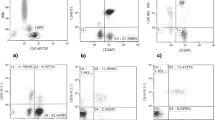Summary
The immune status of breast cancer patients was followed during antiestrogen treatment for at least 1 year or until progression of the disease. Twelve postmenopausal women with advanced estrogen-receptor-positive breast cancer were treated with a novel antiestrogen, toremifene. Immune functions were determined before the start of the treatment and at 3, 6, and 12 months. For NK cell cytotoxicity testing there were 74 healthy controls and for T cell subset measurements 28 healthy controls. No statistically significant changes in the T cell subsets or NK cell cytotoxicity were observed during treatment. However, throughout toremifene treatment patients had fewer CD4 cells (T helper lymphocytes) than did the controls. Cancer patients had higher pretreatment B cell values than the controls,P = 0.01, but during the first months of toremifene treatment B cell values decreased and remained within the normal range thereafter. A positive effect on mitogen-stimulation tests with phytohemagglutinin (PHA) and concanavalin A (ConA) was observed during the first months of treatment (P = 0.01 for PHA and 0.03 for log [ConA] and a stabilization at the higher level thereafter. These results indicate that toremifene has a stimulatory effect on cell-mediated immunity in breast cancer patients.
Similar content being viewed by others
References
Adler A, Stein JA, Ben-Efraim S (1980) Immunocompetence, immunosuppression, and human breast cancer. III. Prognostic significance of initial level of immunocompetence in early and advanced disease. Cancer 45: 2074
Berry J, Green BJ, Matheson DS (1987) Modulation of natural killer cell activity by tamoxifen in stage I postmenopausal breast cancer. Eur J Cancer Clin Oncol 23: 517
Cohen JHM, Danel L, Cordier G, Saez S, Revillard JP (1983) Sex steroid receptors in peripheral T cells: absence of androgen receptors and restriction of estrogen receptors to OKT8 positive cells. J Immunol 131: 2767
Dillman RO, Koziol JA, Zavanelli MI et al. (1984) Immunoincompetence in cancer patients. Cancer 53: 1484
Eskola J, Soppi E, Viljanen M, et al. (1975) A new micromethod for lymphocyte stimulation using whole blood. Immunol Commun 4: 297
Giorgi JV (1986) Lymphocyte subset measurements: significance in clinical medicine. In: Rose NR, Friedman H, Fahey JL (eds) Manual of Clinical an Laboratory Immunology. 3rd ed. Am Soc Microbiol, Washington, DC, p 236
Grossman CJ (1984) Regulation of the immune system by sex steroids. Endocrinol Rev 5: 435
Joensuu, H, Toivanen A, Nordman E (1986) Effect of tamoxifen on immune functions. Cancer Treat Rep 70: 381
Kallio S, Kangas L, Blanco G et al. (1986) A new triphenylethylene compound, FC-1157 A. I. Hormonal effects. Cancer Chemother Pharmacol 17: 103
Kangas L, Nieminen A-L, Blanco, G et al. (1986) A new triphenylethylene compound, FC-1157 A. II. Antitumour effects. Cancer Chemother Pharmacol 17: 109
Mandeville R, Lamoureux G, Legault-Poisson S, Poisson R (1982) Biological markers and breast cancer. A multiparametric study. II. Depressed immune competence. Cancer 50: 1280
Mandeville R, Ghali SS, Chausseau JP (1984) In vitro stimulation of human NK activity by an estrogen antagonist (Tamoxifen). Eur J Cancer Clin Oncol 20: 983
Miller AB, Hoogstraten B, Staquet M, Winkler A (1981) Reporting results of cancer treatment. Cancer 47: 207
Paavonen T, Anderson LC (1985) The oestrogen antagonists, tamoxifen and FC-1157 a, display oestrogen like effects on human lymphocyte functions in vitro. Clin Exp Immunol 61: 467
Paavonen T, Andersson LC, Adlercreuz H (1981) Sex hormone regulation of in vitro immune response. J Exp Med 154: 1935
Paterson AG, Webster DJT (1982) The predictive value of T-lymphocyte counts in advanced breast-cancer patients treated with tamoxifen. Br J Cancer 45: 637
Rotstein S, Blomgren H, Petrini B, Wasserman J, Nilsson B, Baral E (1985) Blood lymphocyte counts with subset analysis in operable breast cancer. Relation to the extent of tumor disease and prognosis. Cancer 56: 1413
Rotstein S, Blomgren H, Petrini B, Wasserman J, Baral E (1985) Long term effects on the immune system following local radiation therapy for breast cancer. I. Cellular composition of the peripheral blood lymphocyte population. Int J Radiat Oncology Biol Phys 11: 921
Rotstein S, Blomgren H, Petrini B, Wasserman J, Baral E (1986) Long-term effects on the immune system following local radiation therapy for breast cancer: 4. Proliferative responses and induction of suppressor activity of the blood lymphocyte population. Radiother Oncol 6: 223
Salo M (1987) Surgery and the immune response. In: Paubert-Braquet M (ed) Lipid mediators in the immunology of shock. Plenum, New York, p 289
Scambia G, Panici PB, Maccio A et al. (1988) Effects of antiestrogen and progestin on immune functions in breast cancer patients. Cancer 61: 2214
Sheard CR, Reilly F, Tee DEH et al. (1986) The effect of adjuvant cyclophosphamide or tamoxifen on the numbers of lymphocytes bearing T cell or NK cell markers. Br J Cancer 54: 705
Toivanen A, Nordman E (1981) Long-term effect of postoperative irradiation on the immune fuctions in patients with mammary carcinoma. Acta Radiol Oncol 20: 119
Valavaara R, Pyrhönen S, Heikkinen M et al. (1988) Toremifene, a new antiestrogenic compound for treatment of advanced breast cancer. Phase II study. Eur J Cancer Clin Oncol 24: 785
Webster DJT, Richardson G, Baum M, Priestman T, Hughes LE (1979) Effect of treatment on the immunological status of women with advanced breast cancer. Br J Cancer 39: 676
West WH, Cannon GB, Kay HD, Bonnard GD, Herberman RB (1977) Natural cytotoxic reactivity of human lymphocytes against a myeloid cell line: characterization of effector cells. J Immunol 118: 355
Wärri A, Kangas L (1990) Effect of toremifene on the activity of NK-cells in NZB/NZW mice. J Steroid Biochem (in press)
Zaccheo T, Ornati G, di Salle E (1986) Antiestrogenic and antitumor properties of the new triphenylethylene derivative toremifene in the rat. 14th International Cancer Congress, Budapest. Abstr 2996
Author information
Authors and Affiliations
Rights and permissions
About this article
Cite this article
Valavaara, R., Tuominen, J. & Toivanen, A. The immunological status of breast cancer patients during treatment with a new antiestrogen, toremifene. Cancer Immunol Immunother 31, 381–386 (1990). https://doi.org/10.1007/BF01741410
Received:
Accepted:
Issue Date:
DOI: https://doi.org/10.1007/BF01741410




